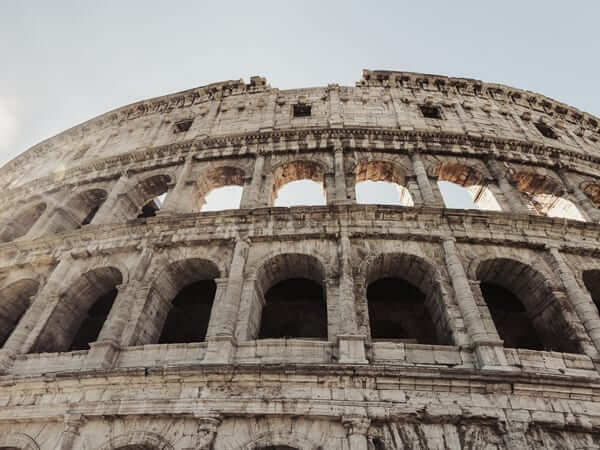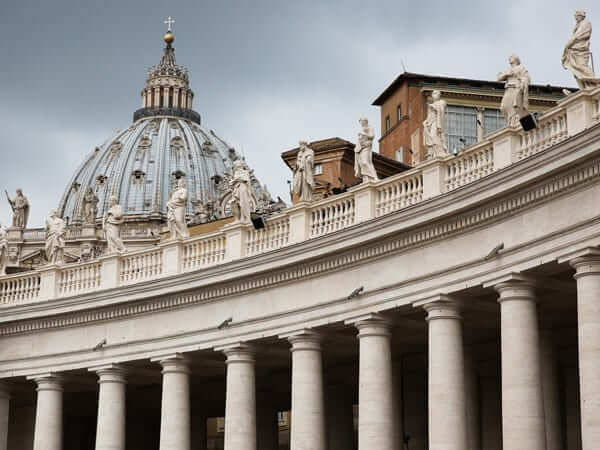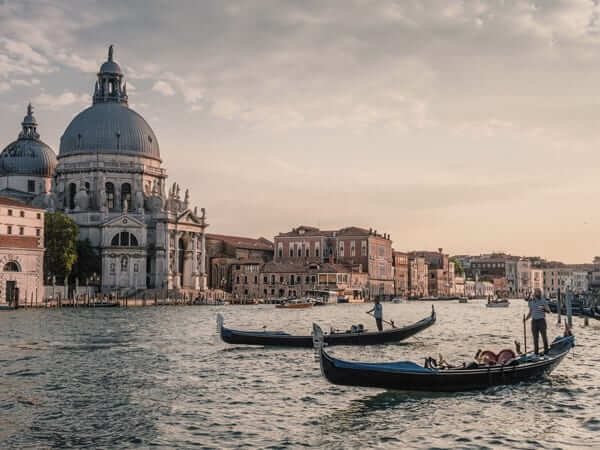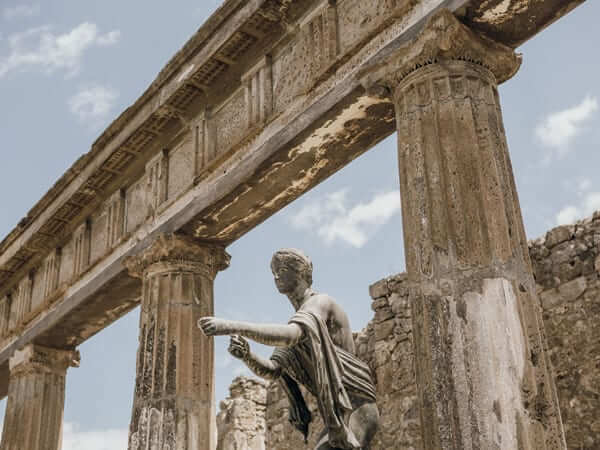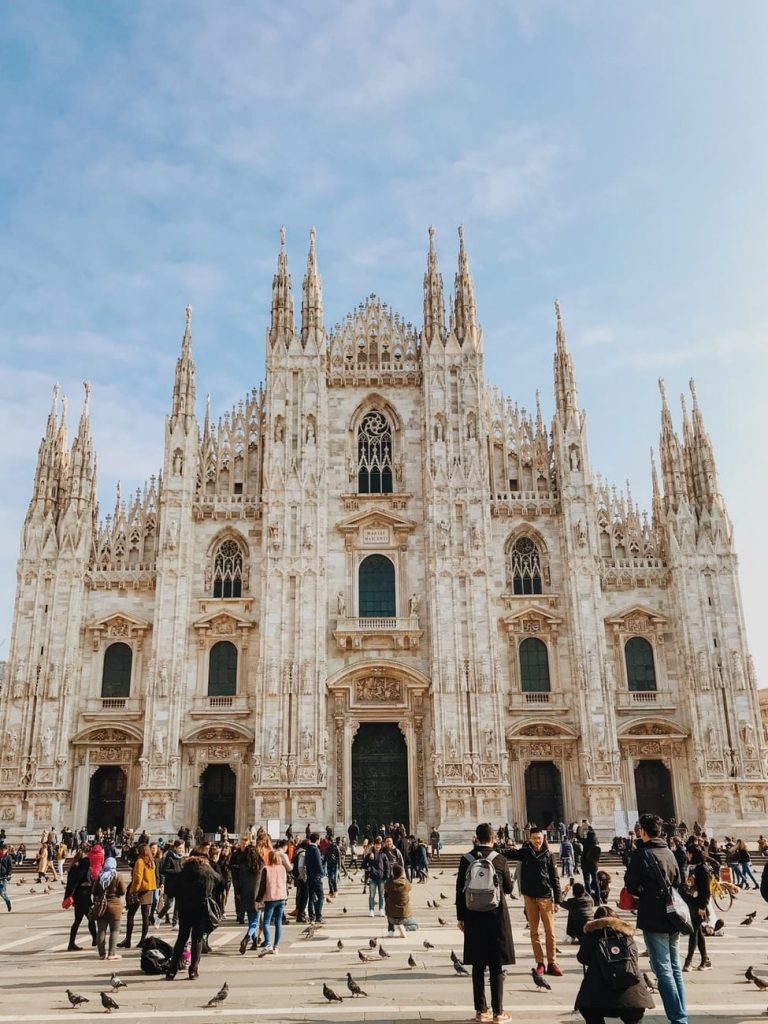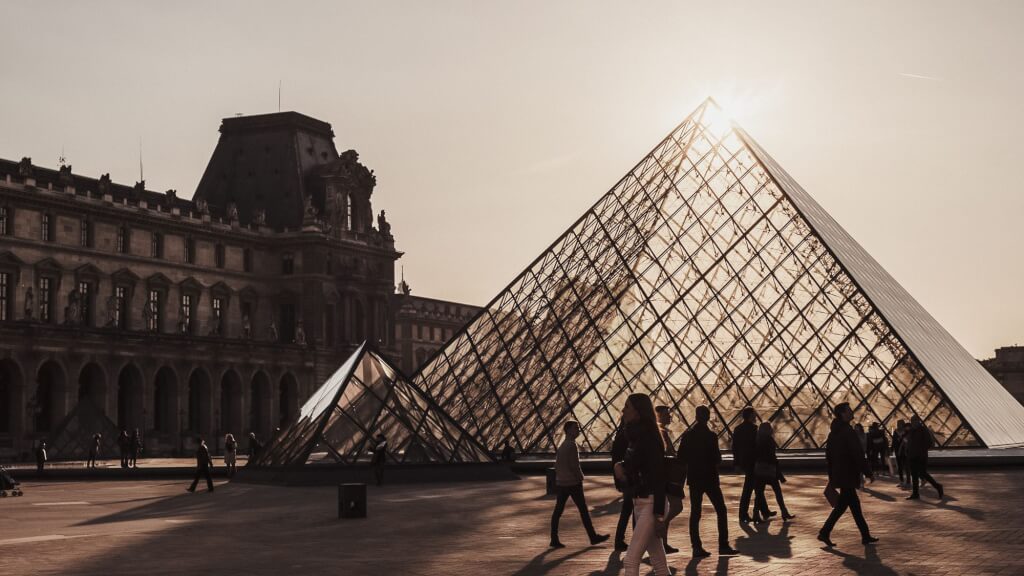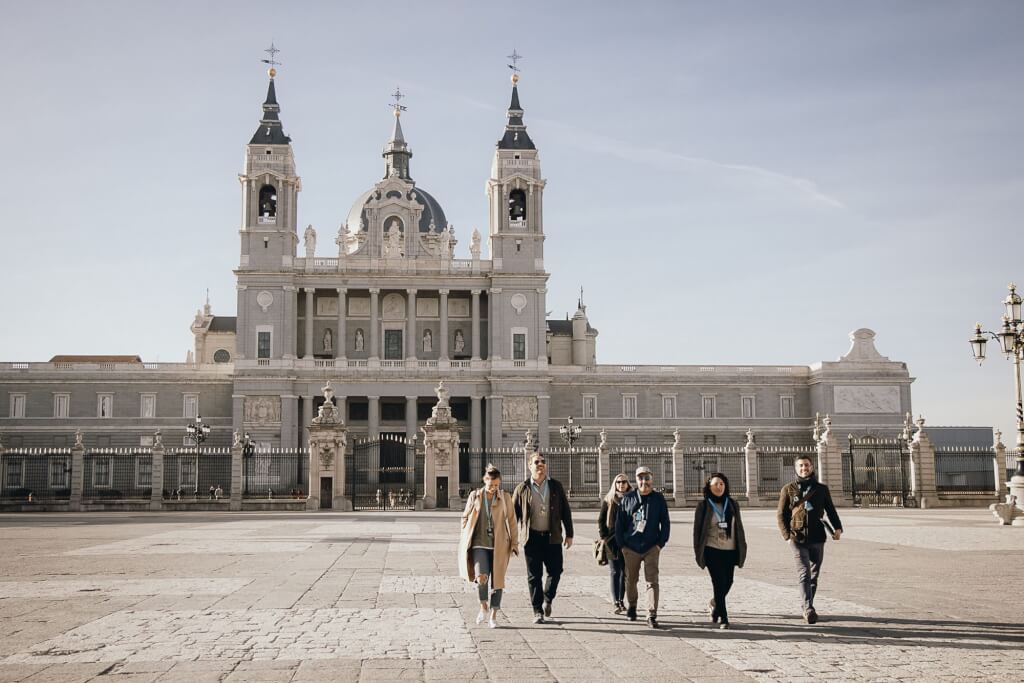We have never met someone who visited Italy without stepping inside at least one church to marvel at the art and architecture on display. Churches in Italy stand among the world’s most impressive buildings, and it’s no wonder religious tourism draws so many travelers. Their interiors and exteriors embody the history of Italy and remain some of the most jaw-dropping monuments in the country, often attracting those on a spiritual journey or even a modern-day pilgrimage.
Though thousands of cathedrals, churches, and chapels fill Rome alone—let alone all of Italy—some stand out above the rest based on their size, their art, the elegance of their design, or their ability to awe and inspire those who step through their doors. Many of these sacred sites even receive recognition as UNESCO World Heritage treasures. Consequently, they serve as essential stops for anyone interested in Italy’s faith, history, and culture.
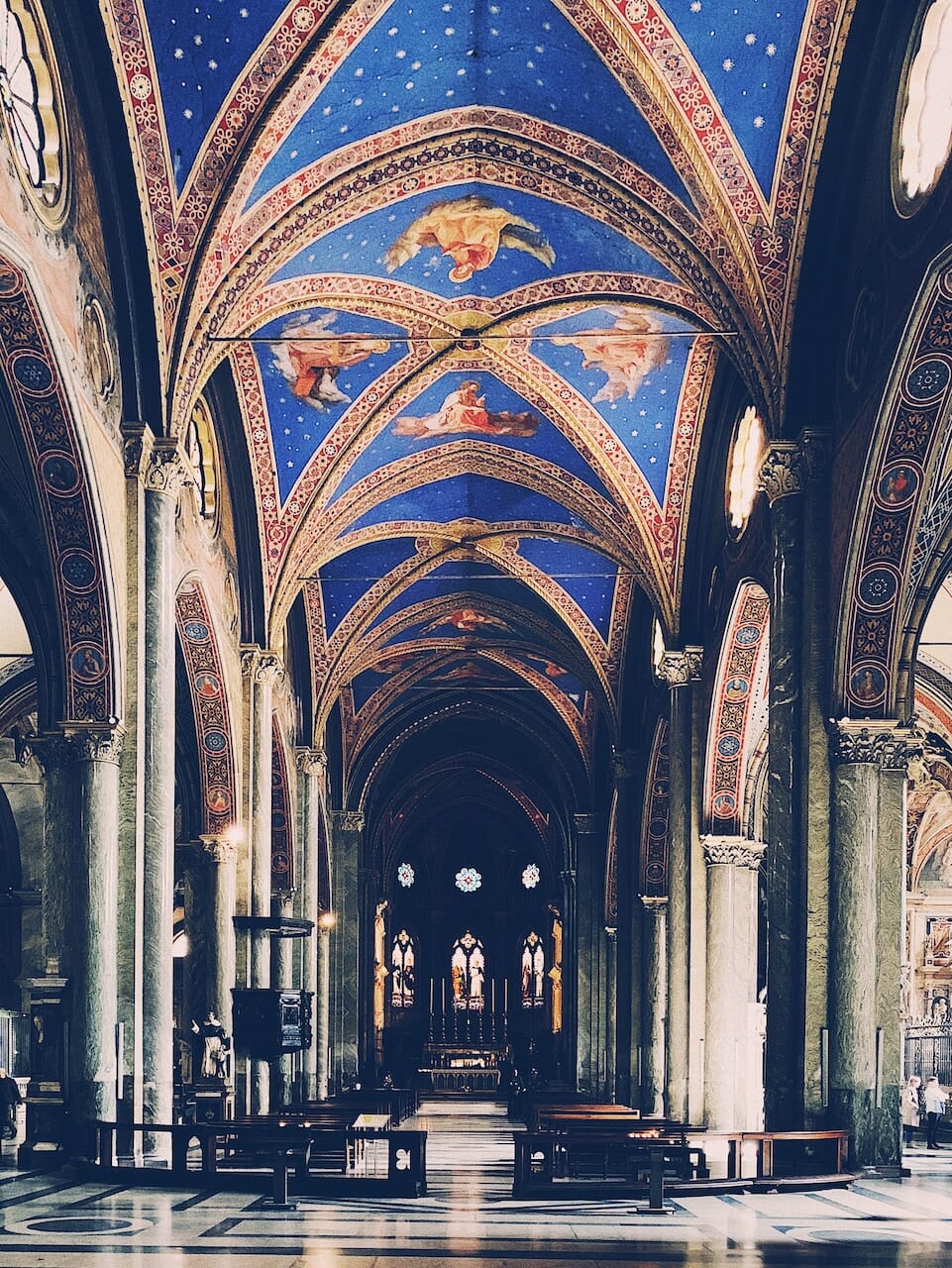
Table of Contents
Toggle20 Must-See Churches in Italy
Santa Maria Assunta (Duomo di Siena), Siena
Santa Maria Assunta is another massive Duomo dedicated to Saint Mary of the Assumption, but it has a few features that really make it stand out. For one, Siena’s cathedral earns our vote for the most all-around beautiful church in Italy inside and out.
While the facade drips with beautiful stonework, the inside dazzles as a treasure trove of frescoes, paintings, and gothic/Romanesque architecture. Don’t forget to look down: the floor features intricate marble mosaics that rank among the best of their kind anywhere in the world. If these things aren’t enough, the cathedral also contains the Piccolomini Library (packed with illuminated choir books and frescoes), a crypt, a baptistry, and a museum—all of which merit visits.
If you want to climb to the top of Siena’s Duomo, then the best way to see this church is the “Gate of Heaven” tour. This tour allows you to see both the inside and outside from a birds-eye view!
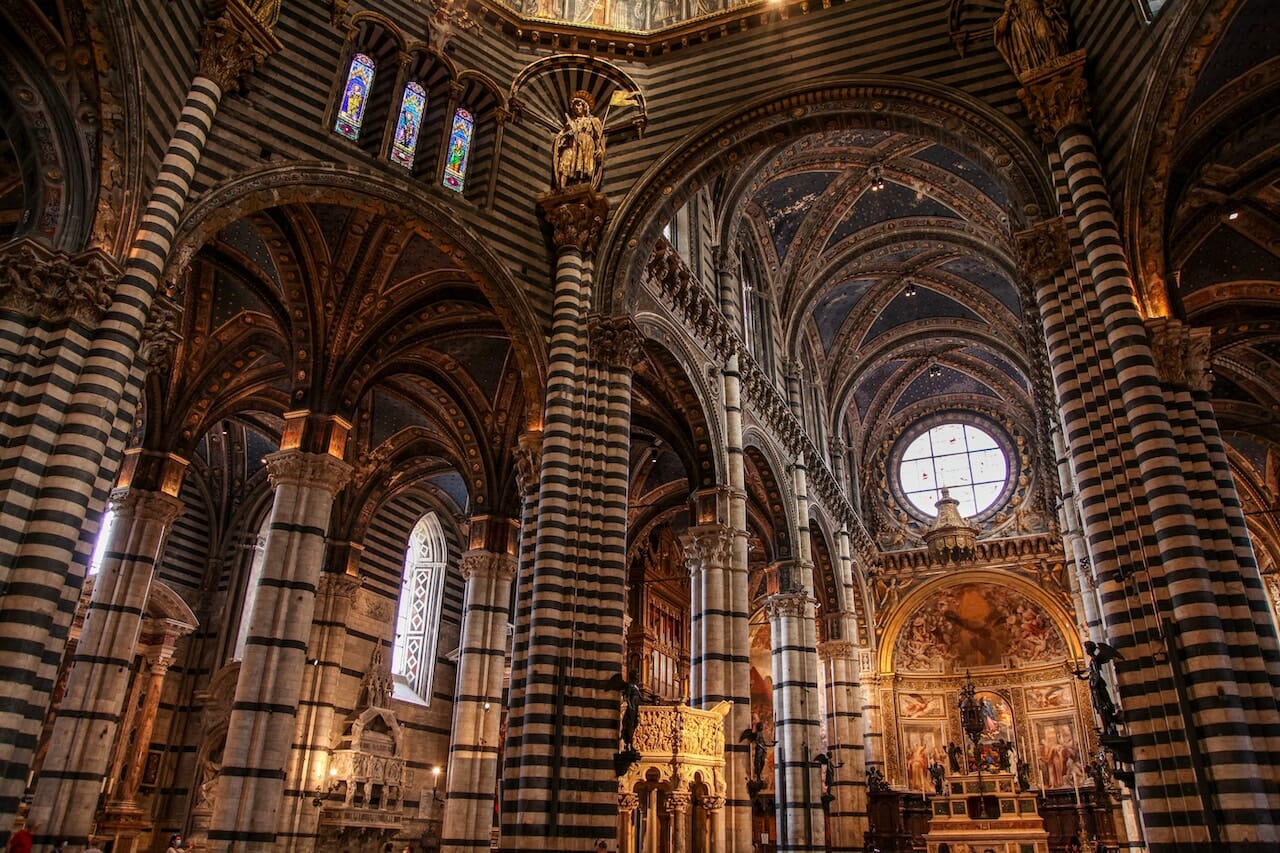
Santa Maria del Fiore, Florence
Like most cathedrals in Italian cities, Florence’s main cathedral is more often called, simply, the “Duomo.” Unlike most cathedrals in Italy, however, the actual Dome of this Duomo stands as a historical and architectural wonder!
Though construction on the Cathedral started in 1296, the structure’s dome wasn’t begun until the 15th century, some 200 years later. The problem was that no one on earth in the 13th century knew how to build a dome large enough to fill the space left for it, which ran 150 feet wide and 180 feet off the ground. The winning solution came from a goldsmith—and boy genius—Filippo Brunelleschi. The artist suggested building two domes, one inside the other, to address not only the space but also the pressure inherent in such a large structure.
Brunelleschi began work on the project in 1420, and today the magnificent outcome stands proud in the center of Florence, an enormous brick masterpiece, visible from nearly every corner of the Renaissance city. Along with Rome’s Pantheon and St. Peter’s Basilica, Santa Maria del Fiore can rightly be considered a building that changed the course of architectural history.
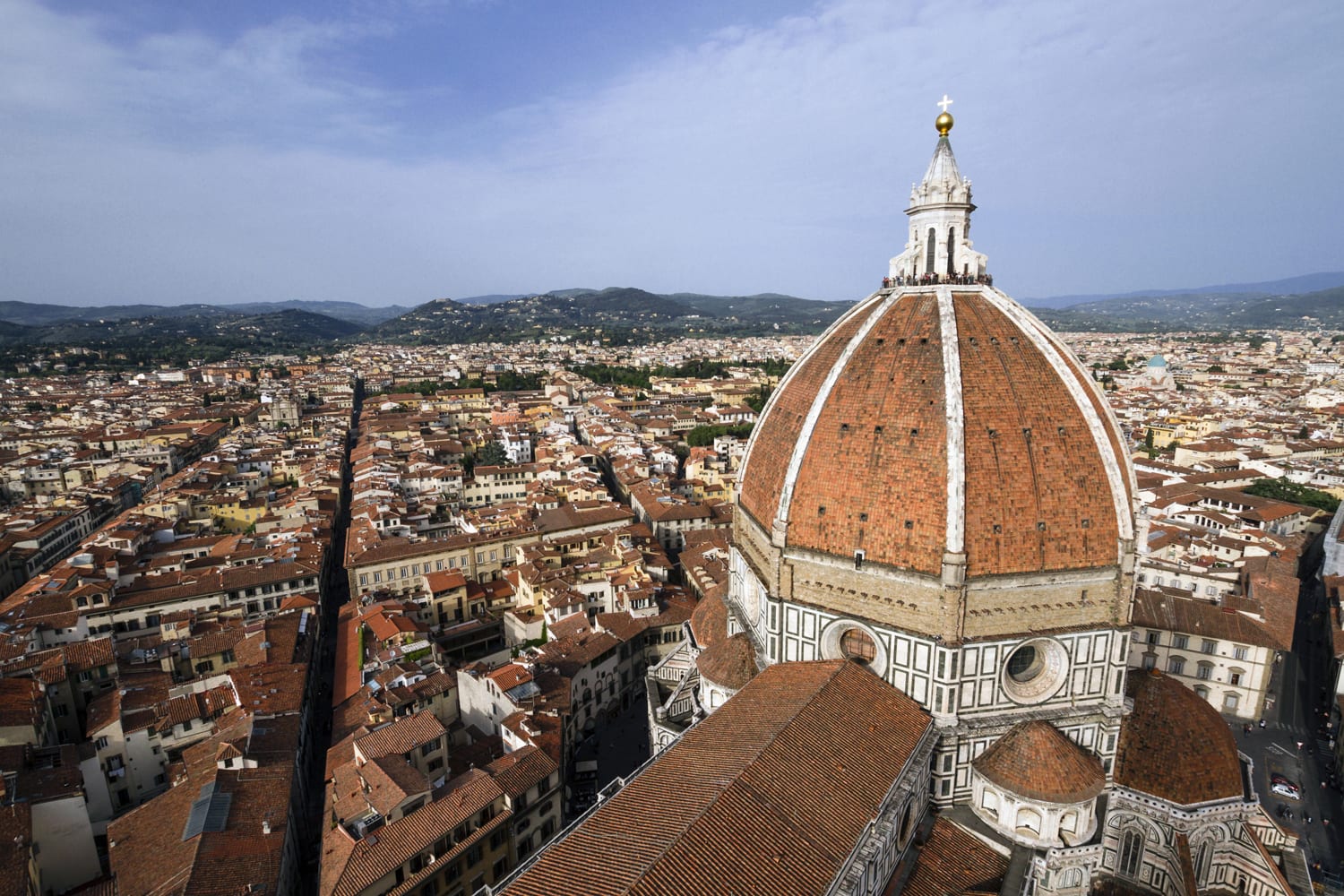
St. Peter’s Basilica, Vatican City
Though technically in the Vatican City, the tiny city-state that shares the riverbanks with Rome, St. Peter’s Basilica is one Cathedral you absolutely can’t miss. The biggest cathedral in the world and the heart of the Catholic Church, St. Peter’s rises as the superman of churches, impressive enough to awe any visitor.
Supposedly built on the tomb of St. Peter, an original Apostle of the Catholic Church, the Basilica that you see today actually replaces an earlier church, but it far surpasses the first. Michelangelo designed its dome, Bernini created its colonnade and baldachin, and a Pantheon of Great Italian artists contributed decorations.
When you step inside, “awe” only begins to describe what you feel. Every major Catholic feast day is celebrated here by the Pope himself.
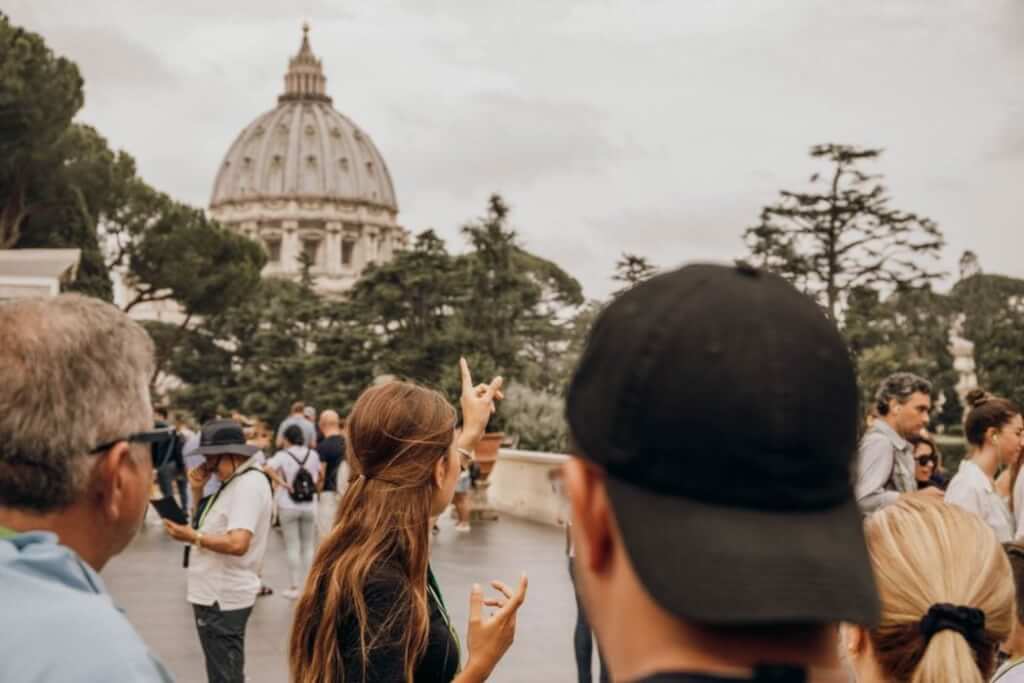
Santa Maria Nascente, Milan
The behemoth Duomo of Milan, as it’s nearly always called, is the fourth biggest Catholic Church in the world and definitely one of the most Gothic.
Though its style changed over the course of its 600-year construction, the gargoyles, spires, and spikes decorating its white marble façade place it squarely among Italy’s most Gothic churches. It also ranks as one of Italy’s biggest, taking up an entire city block!
Tour inside to see the massive pillars supporting the stained glass arches, then head up the stairs (or the conveniently placed elevator) to the Duomo’s terrazza, the cathedral’s roof, where you can view the gargoyles up close and look out over Milan clear to the Alps beyond.
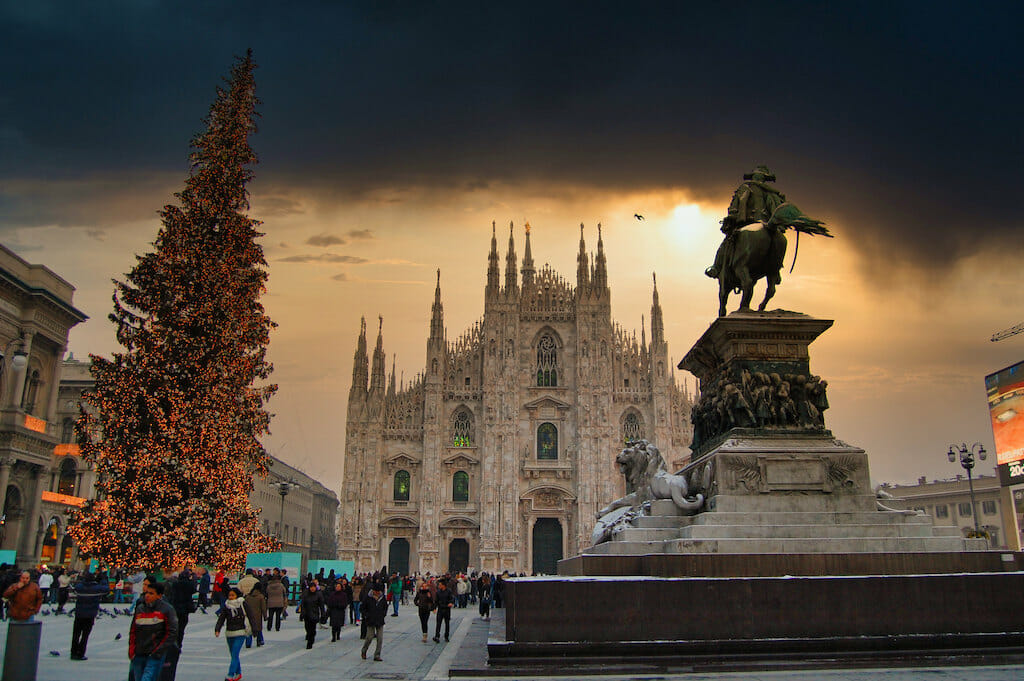
Santa Maria sopra Minerva, Rome
If Milan’s Duomo holds the title for most impressive Gothic facade in Italy, Santa Maria sopra Minerva claims the most impressive Gothic-style interior.
One of the few Gothic churches in Rome, whose style tends toward Baroque, the 13th century church dazzles with some of the most stunning vaulted ceilings of any church in Italy. Luminous ultramarine with golden stars covers the ceiling, as if the most vibrant night sky was directly above you.
It’s said the Basilica stands atop the ruins of a temple for Minerva (where it gets its name), one for the Egyptian goddess Isis, and one for the Greco-Egyptian god Serapis. Today, it serves as one of Rome’s most important Basilicas and even houses the tomb of St. Catherine of Siena, a patron saint of Italy.
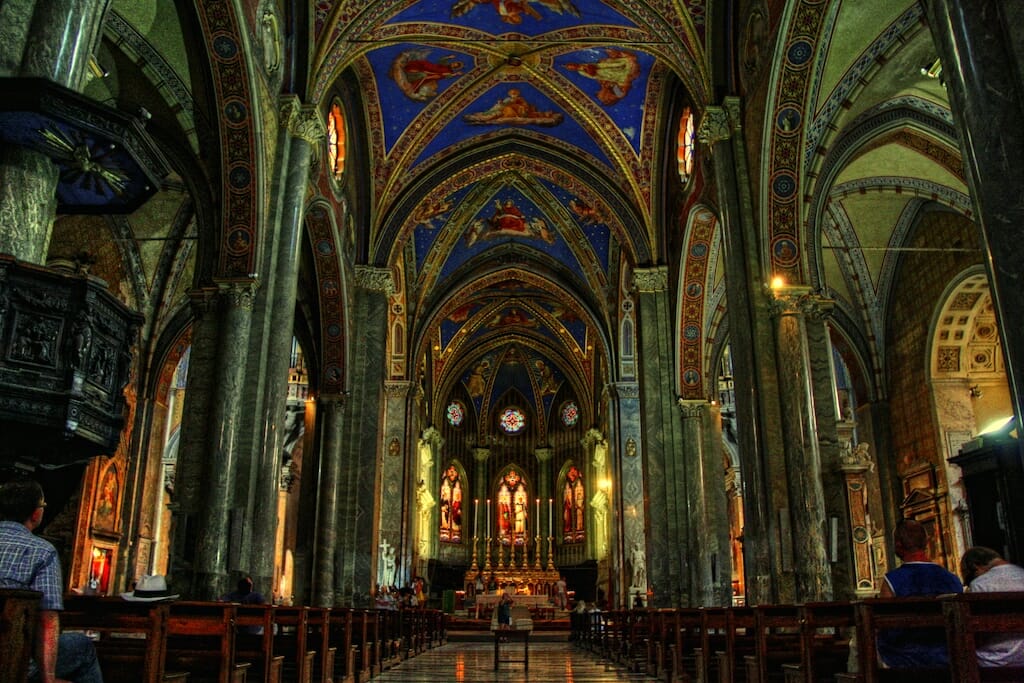
The Pantheon, Rome
The Pantheon originally served as a Roman temple in AD 124, dedicated to the citizens’ various gods. Later, in AD 609, it was converted into a Christian church; however, the austere architecture and eerie symmetry still give the building an unmistakably pagan air.
This incredible structure has influenced nearly every serious architect since the Renaissance, making it one of the most significant buildings in the entire world. Even today, it boasts the largest unreinforced concrete dome on earth. Remarkably, ancient Roman builders achieved this feat nearly 2,000 years ago, and no one has surpassed it. As a result, the Pantheon stands as the best-preserved ancient Roman building in all of Rome!
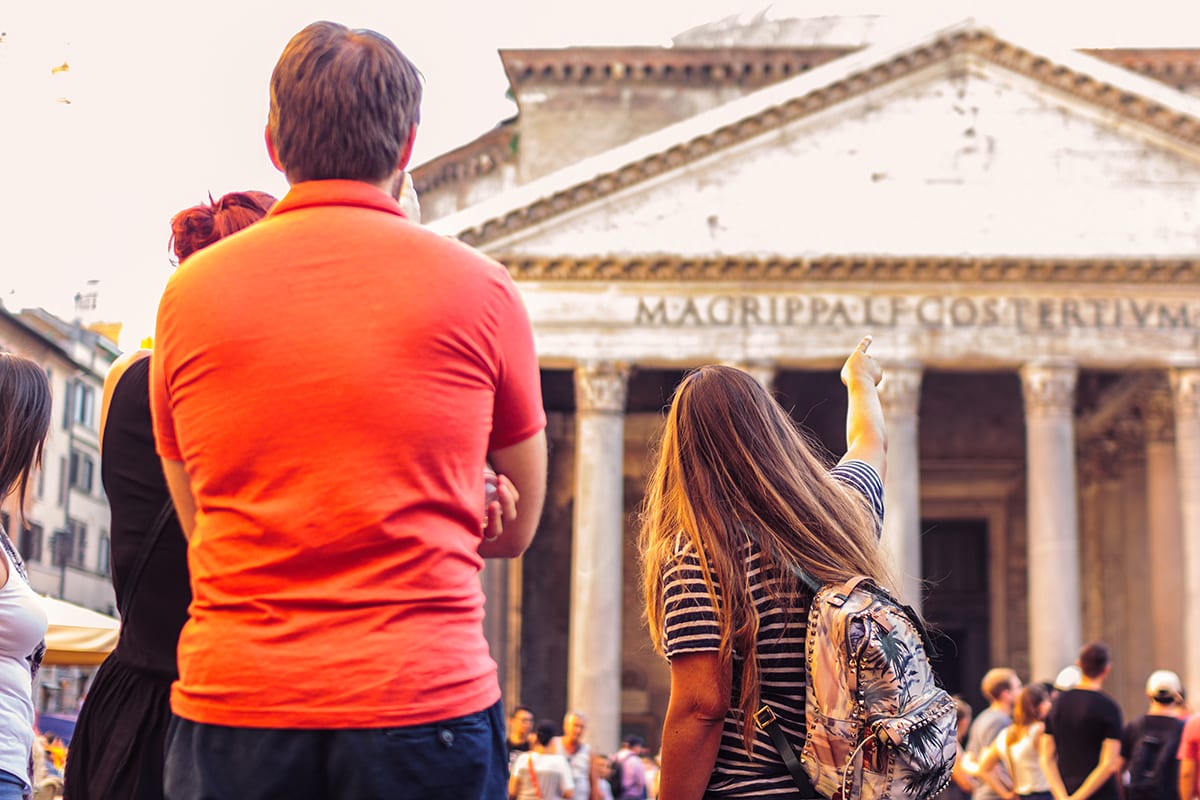
St. Mark’s Basilica, Venice
In a country full of Medieval, Renaissance, and Baroque churches, St. Mark’s uniquely displays Byzantine mastery.
This style of art originated in the Eastern Roman Empire, which counted Constantinople as its capital, and exerted political and social influence over much of Eastern Europe and the Near East. No other Cathedral in Italy preserves as much Byzantine influence as St. Mark’s; consequently, the church boasts over 85,000 feet of golden mosaics.
The 11th-century Basilica stands as a tribute to St. Mark, an apostle and Venice’s patron saint. Under his aegis, Venice played a key role in the sacking of Constantinople in 1204—a foray which filled their coffers with loot and contributed a lot of the gold and art you see in the church today. Perhaps no other church in Italy represents the history and culture of its city as well as this magnificent Basilica.
Notable highlights of St. Mark’s Basilica include:
- Over 85,000 square feet of golden mosaics
- Unique Byzantine architecture unmatched elsewhere in Italy
- Opulent treasures and art, much of it brought from the East
- The nickname “Chiesa d’Oro” (Church of Gold) due to its glittering interior
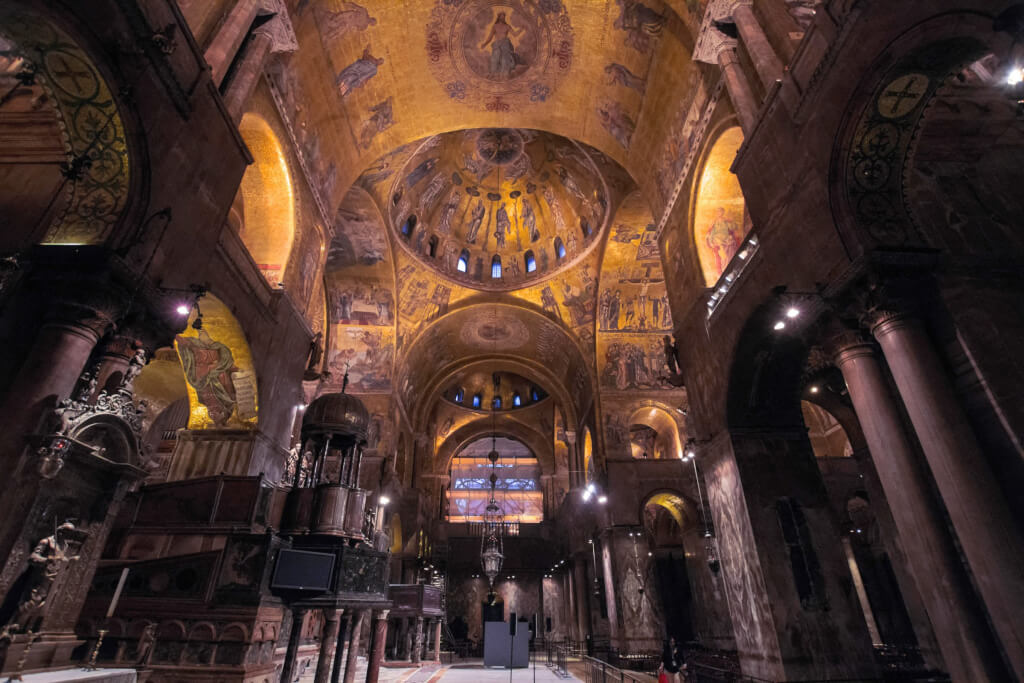
Cattolica di Stilo, Stilo
St. Mark’s Cathedral may be the best-known Byzantine church in Italy, but others exist. The Cattolica di Stilo perhaps best exemplifies Byzantine-Catholic architecture in the south.
Located in Calabria, right on the toe of the Italian peninsula, the 9th century church arose when the Byzantine empire still controlled Southern Italy. While St. Mark’s bursts with Venetian Opulence, this gem survives as one of the best examples of the austere Eastern monastic tradition.
Though the church is tiny and the façade unassuming, its diverse history—mixing Byzantine, Roman Catholic, and Arabic influences—truly stands out. Perched on the side of a mountain, its red and brown brick towers nearly blend into the slope, but the views it offers over the town, valleys, and sea below are second to none.
St. Antonio Trullo Church, Alberobello
When in Rome, do as the Romans do, and when in Alberobello, do as the Alberobellians—and by that we mean visit a trulli church!
Alberobello is a small town and UNESCO World Heritage Site in Puglia made famous by its traditional trulli houses, or ancient cone-shaped peasant houses. Naturally, the town’s churches follow the same style. Though it’s a relatively young candidate on this list (it was finished in 1927), the St. Antonio (St. Anthony) Church perfectly mixes Puglia’s ancient construction techniques and modern-day conservation sensibilities. It also beautifully illustrates the cultural importance of Alberobello’s unusual architecture.
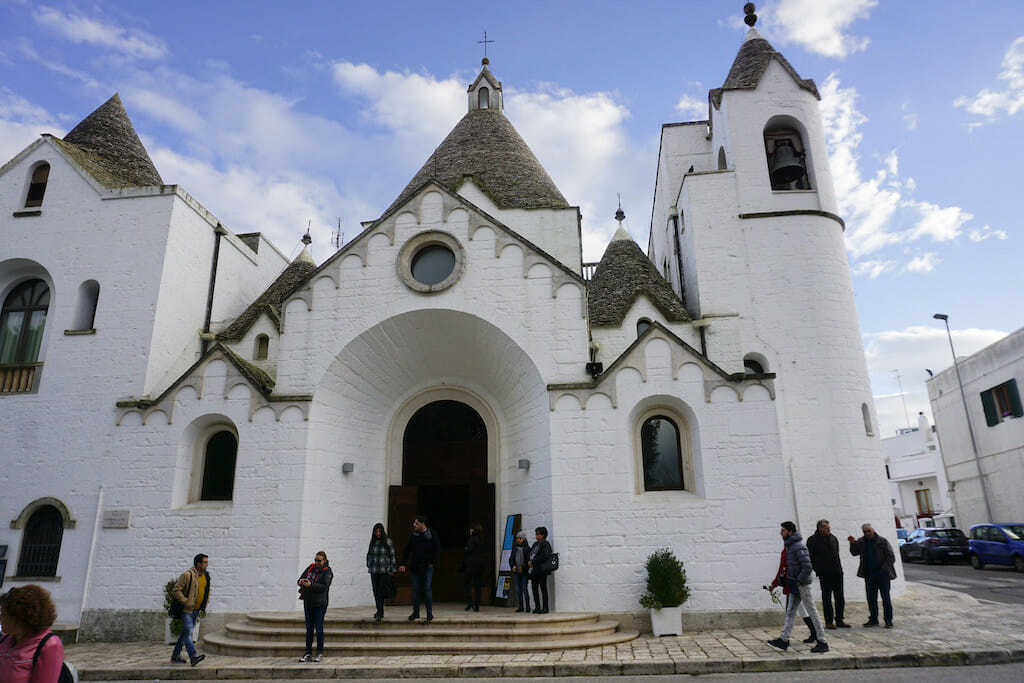
The Church of Curon, South Tyrol
This church in South Tyrol sits in Lake Resia. No, you’re not overlooking it—its remains are actually submerged in the lake! Today, only the 14th-century bell tower of the Church at Curon is still visible or visitable. The rest sits under water.
The town, located on the border of Italy and Austria, was flooded to create a lake. The only visible remnant is the beautiful bell tower poking up through the surface of the placid lake. Depending on the water level, you can also spot part of the semi-submerged church at times. Of course, you won’t attend mass here anytime soon, but visitors in the winter can walk out to the bell tower when the lake freezes. The strange sight remains surprisingly beautiful year-round.
Santa Maria d’Idris, Matera
This church stands in Matera, a UNESCO World Heritage Site renowned for its unique dwellings literally cut into caves in the side of a mountain.
Like many of the buildings in Matera, Santa Maria d’Idris occupies a small cave on top of a cliff. The atmosphere is certainly unique, if not a bit eerie. The ancient rock city contains dozens of caves carved throughout it, many of which churches now occupy. This one, in particular, overlooks the canyon of Matera and contains gorgeously frescoed “meditation chambers” that testify to the monastic lifestyle once led within the bare stone walls.
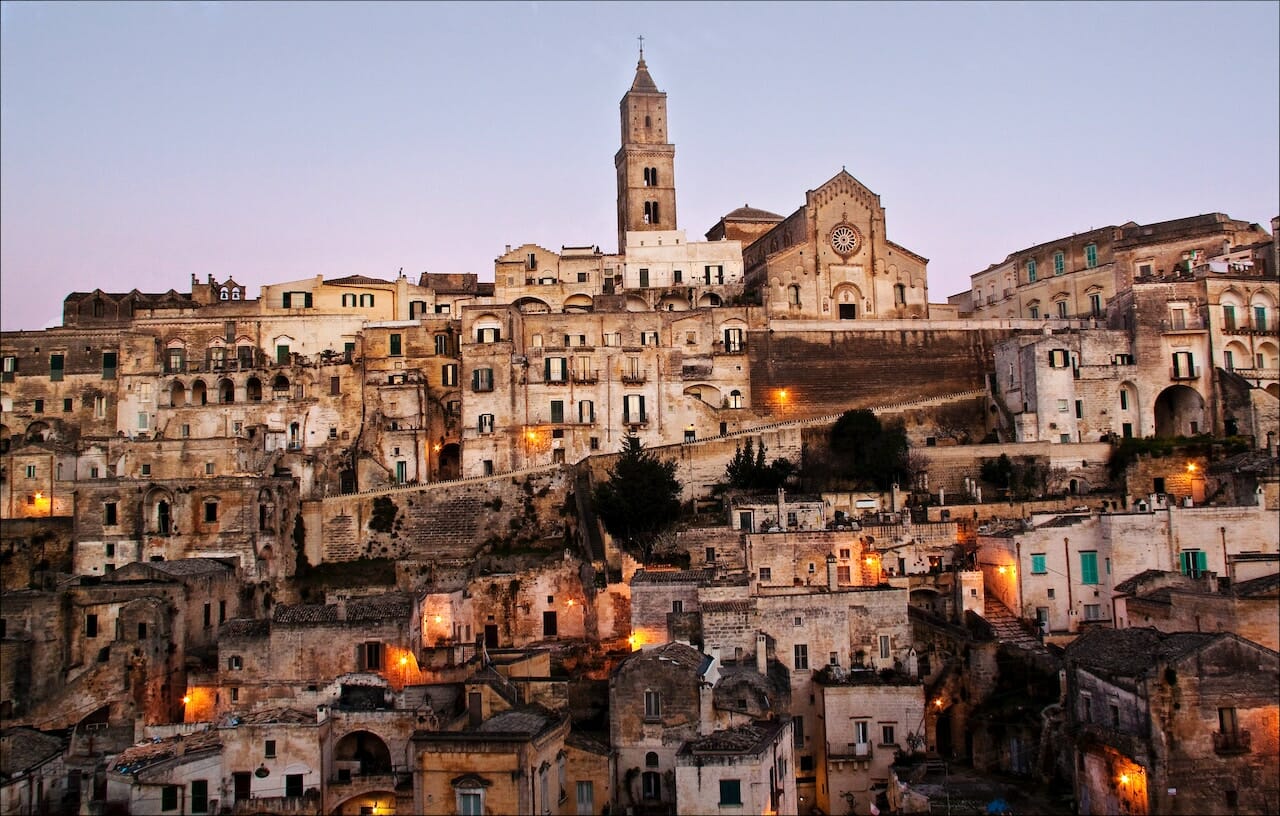
Basilica di San Vitale, Ravenna
Ravenna is renowned for the magnificent Byzantine mosaics scattered throughout the city. Notably, the best of these mosaics appear in the Basilica di San Vitale.
Originally composed in the 6th century, these incredible works of what is now considered a dying art stand without parallel in their skill and execution. The walls and ceilings are absolutely covered in glittering gold scenes and incredibly detailed motifs. Given the honorary title of “basilica” for its historical and religious importance, San Vitale is also one of several UNESCO World Heritage Sites in Ravenna you should visit!
Basilica di Santo Stefano, Bologna
The beauty and mystery of Santo Stefano is that it actually brings together many churches in one. Locals refer to it as the sette chiese, or “seven churches” because its original layout comprised (an estimated) seven churches, each constructed at a different time between the 4th and 13th centuries.
Catholic tradition holds that the complex sits atop a temple of the Egyptian goddess Isis. An even harder to prove legend states that the seven churches were each meant to represent locations of the Passion of Christ. After significant restoration projects over the years, only four distinct churches remain visible today, but the Basilica continues to rank as one of the most fascinating of Bologna’s religious buildings.
When visiting the Santo Stefano complex, make sure to:
- Explore the crypts and ancient graves that reveal layers of history
- Marvel at the artistic frescoes decorating the chapels
- Enjoy the tranquil courtyards and peaceful cloisters
- Learn about the intriguing legends and mysteries tied to its origins
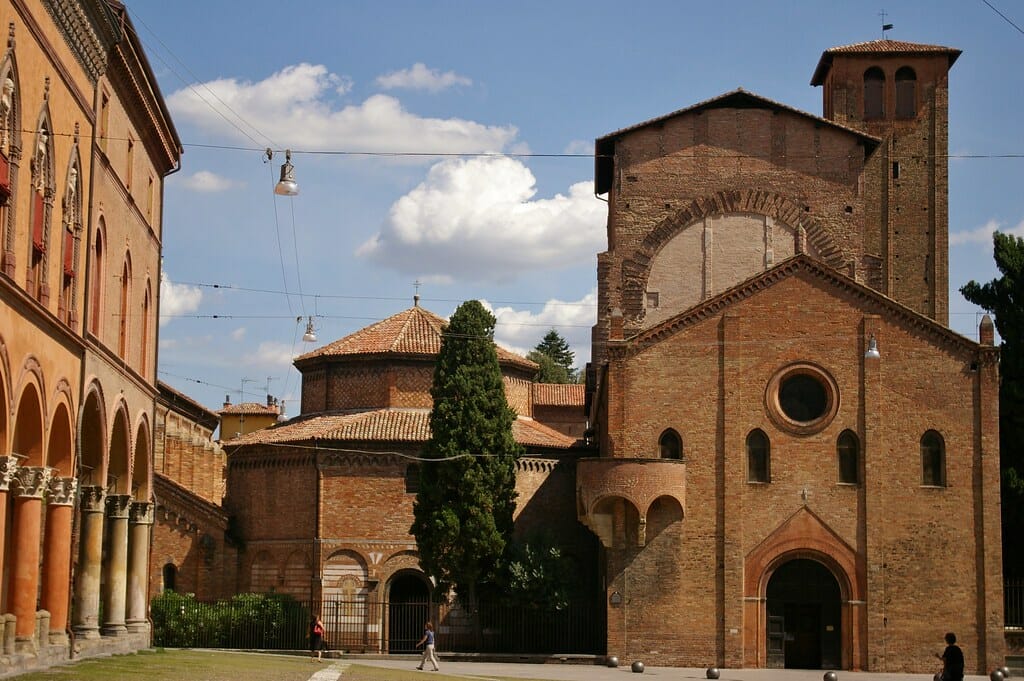
Church of Domine Quo Vadis (Santa Maria delle Piante), Rome
This 9th century church sits right on the Via Appia, or Appian Way, Rome’s famous ancient highway and another must-see Roman attraction.
Legend says this is the spot where Peter encountered a vision of Christ as he fled Nero’s persecution in 64 AD. He asked Christ, “Domine, quo vadis?” or “Lord, where are you going?” Jesus indicated that he was heading back to Rome, convincing (or perhaps guilting) Peter to return and face martyrdom. Inside the church, you can see the stone that supposedly has the footprints of Jesus.
Basilica of St. Francis of Assisi, Assisi
Few of the churches on this list offer an interior as unique, impressive, and historic as the Basilica of St. Francis in Assisi, Umbria.
The 13th-century basilica splits into two levels, the upper and the lower, and each showcases impressive art. The upper level, or Basilica Superiore, dazzles with 28 floor-to-ceiling frescoes by Giotto (with extensive help from members of his school), which probably serve as the main artistic stars of the church. Each fresco tells a scene from St. Francis’ life. Though centuries old, the frescoes still appear fabulously vibrant and historically jaw-dropping. Below, in the Basilica Inferiore, you can find work by Cimabue, Pietro Lorenzetti, and Simone Martini, as well as St. Francis’ crypt.
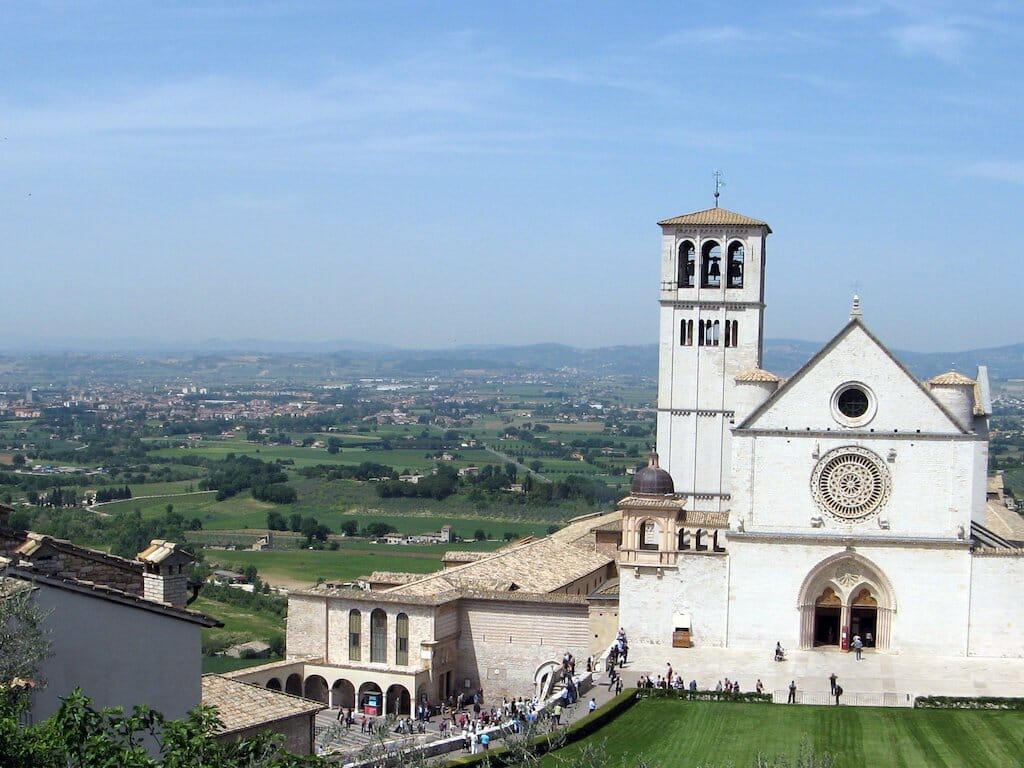
Monreale Cathedral, Palermo
One of the oldest churches on the list, 12th-century Monreale Cathedral in Palermo stands as the best example of Norman architecture on this list. In its opulent interior and vibrant mosaics, you’ll see a perfect mix between Byzantine and Sicilian influence. The entire interior is covered with the aforementioned mosaics, all in gold, covering 68,220 square feet in total. They say these mosaics are second only to the Hagia Sophia in size, though much better preserved and much less known.
After you admire the mosaics, the biblical reliefs, and the intertwined columns in marble and tufa, notice also the enormous bronze doors, some of the only in all of Europe. Then climb to the terrace for a panoramic view over the sea and the bay of the Conca d’Oro.
Santa Maria Assunta, Orvieto
Orvieto might be small, but you’d never know it looking at its cathedral. Its incredible façade took over 200 years to create, with at least five different artists contributing. The Romanesque-Gothic architecture glitters with gold mosaics and perfectly carved marble. A jaw-dropping stained-glass rose window dominates the center. The Duomo dazzles with detailed columns and elaborate frescoes detailing the life of Mary. Truly, this church stands as a design exaggeration for such a small town and a beautiful sight in the Umbrian hills!
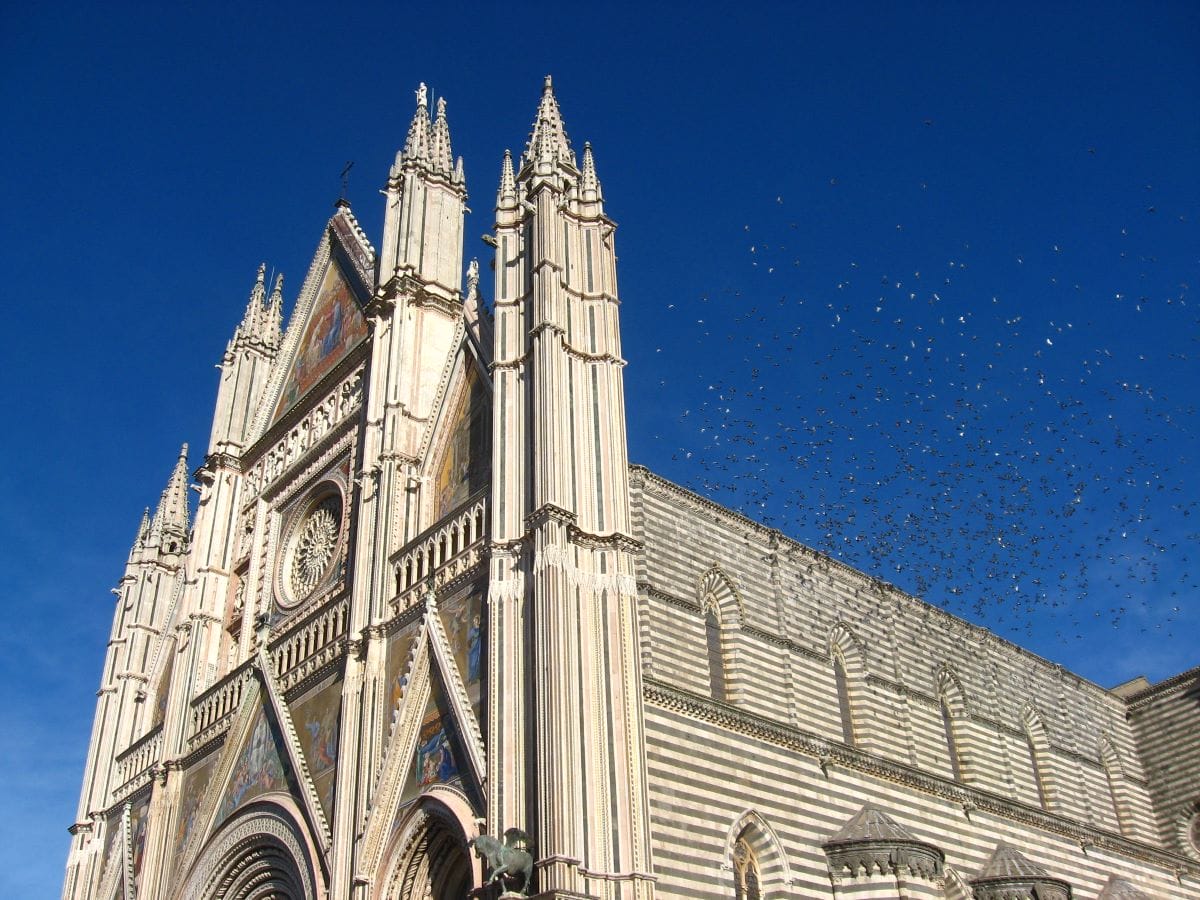
St. Agatha’s Cathedral, Catania
St. Agatha’s Cathedral stands as a testament to the determination of man in the face of nature. Built in the 12th century, the cathedral endured destruction several times because of earthquakes and eruptions from nearby Mount Etna. Just a little over one hundred years after its construction, an earthquake destroyed it. A later fire, followed by another earthquake, left the church in ruins.
Since its rebuilding in 1711, the church has weathered eruptions, wars, and even more earthquakes. Still, the white church stands proud and beautiful in Catania, composed largely of volcanic stones. It also boasts the third largest bell tower in all of Italy, after St. Peter’s Basilica and the Duomo of Milan.
Basilica of San Miniato al Monte, Florence
Standing atop the only hill in Florence proper, the San Miniato al Monte Basilica lords over the city. Local and visitor alike make the hike up to Piazzale Michelangelo (it takes about 20 minutes, though buses are available) in order to enjoy one of the best views over Florence!
The Basilica sits alongside an adjacent monastery on one side and a cemetery on the other. Inside, the 13th-century church has changed little over the years, and even the atmosphere feels decidedly old. At dusk, you might catch the church interior illuminated by candles!
Go before closing time (around 7pm, 8pm in summer) to tour the church, then stick around to watch the sun set over Florence, and the churches below turning on their lights.
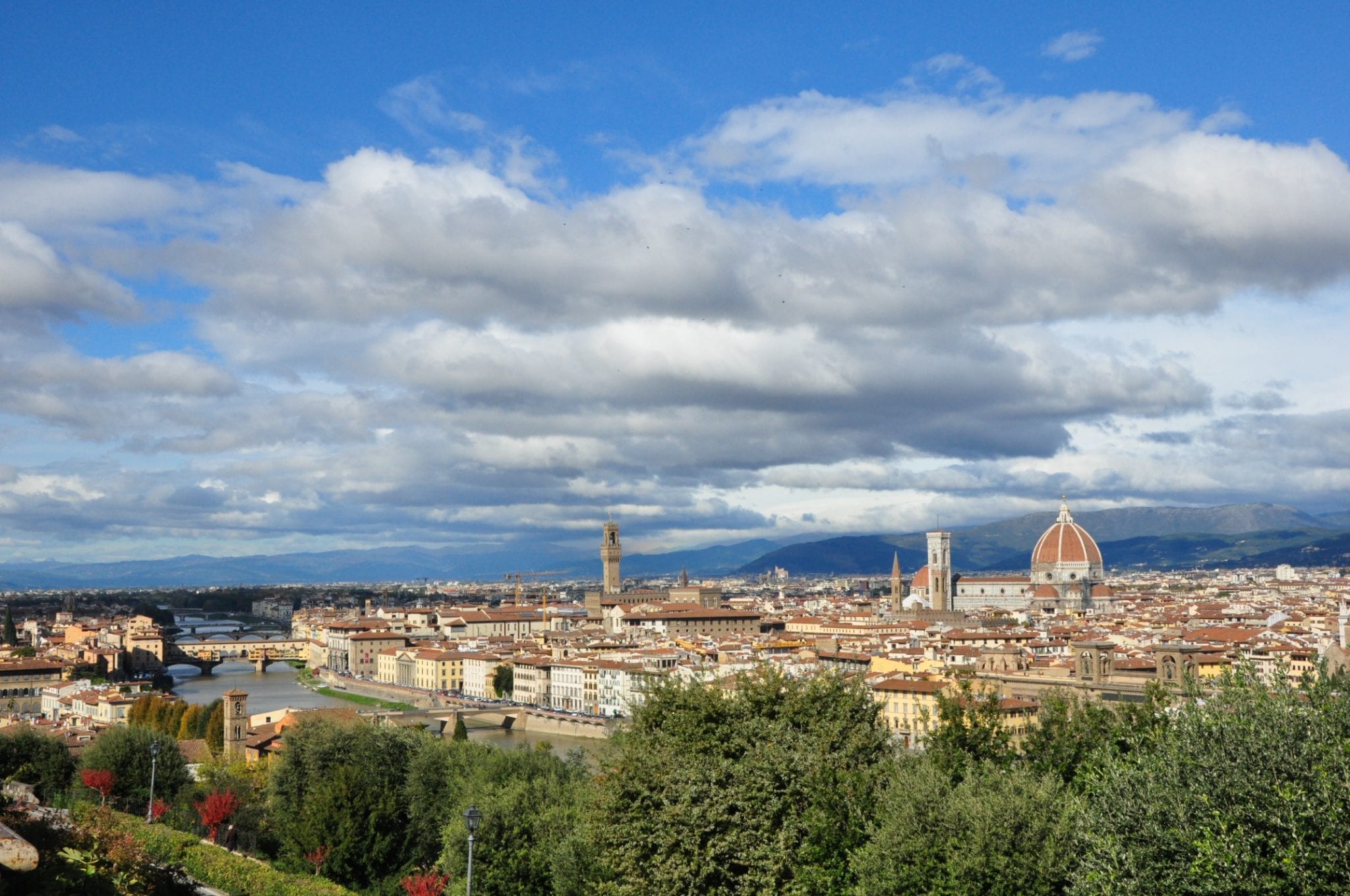
Basilica della Santa Casa (The Basilica of the Holy House of Mary), Loreto
This Basilica of the Holy House arose in the 15th century atop a small shrine that is much, much older. According to Catholic tradition, this shrine is the actual house of the Virgin Mary—not only where she lived but also where Jesus himself was conceived and raised.
Catholic belief says angels miraculously moved this house from its original location in Nazareth to Croatia to protect it during attacks by the Turks in the 13th century. Three years later, angels saved the house again during the Muslim invasion of Albania, moving it to a town called Recanati in the region of Le Marche.
Its third and final move brought the Basilica of the Holy House to its present location in Loreto. Modern investigations by the church support the claim that the house originated in the Holy Land, though historians tend to refute the role of angels in favor of more quotidian crusaders and wealthy benefactors who paid for the house’s various moves. Either way, this basilica houses one of Catholicism’s most important relics—not to mention a ton of history. It remains an impressive sight for Catholics and non-Catholics alike.
Insider’s tip: Find out more about the jaw-dropping properties owned by the Catholic Church.
FAQ: Visiting Italian Churches & Sacred Sites
Why are Italian churches such popular destinations for religious tourism?
Italian churches are not only architectural masterpieces, but also sacred sites that attract millions of people each year. Many visitors embark on a spiritual journey or pilgrimage to these churches, drawn by their rich history, stunning art, and the unique sense of peace found within their walls. Some are UNESCO World Heritage sites, making them even more significant for travelers seeking both culture and faith.
What makes a church a UNESCO World Heritage site in Italy?
A church can be recognized as a UNESCO World Heritage site if it represents outstanding universal value in terms of history, art, architecture, or spirituality. Many Italian churches are included for their artistic treasures, unique construction, and enduring importance to spiritual and cultural life.
Are there any tips for respectfully visiting sacred sites in Italy?
Yes! Dress modestly (covering shoulders and knees), speak quietly, and avoid visiting during Mass unless you plan to participate. Photography is often allowed, but always check for signs. Remember, these sites are not only historical landmarks but also active places of worship and important stops on many people’s pilgrimage or spiritual journey.
Can I visit these churches even if I am not religious?
Absolutely. Many travelers visit Italian churches for their historical and artistic value, as well as their role in Italy’s cultural heritage. Whether you’re on a spiritual journey or simply interested in architecture, you are welcome—just remember to be respectful.
What’s the best way to plan a spiritual journey or pilgrimage through Italy’s churches?
Start by identifying sacred sites or churches that resonate with you, especially UNESCO World Heritage locations. Some travelers follow established pilgrimage routes, while others create their own itinerary based on personal interests. Many churches have official websites with visitor information, and guided tours can provide deeper insight into the art, history, and spiritual significance of each site.
Ready to explore Italy’s most beautiful churches? Make sure to add these sacred sites to your list—whether for religious tourism, a personal pilgrimage, or simply for the love of art and history, these architectural wonders are not to be missed!
by Gina Mussio
View more by Gina ›Book a Tour
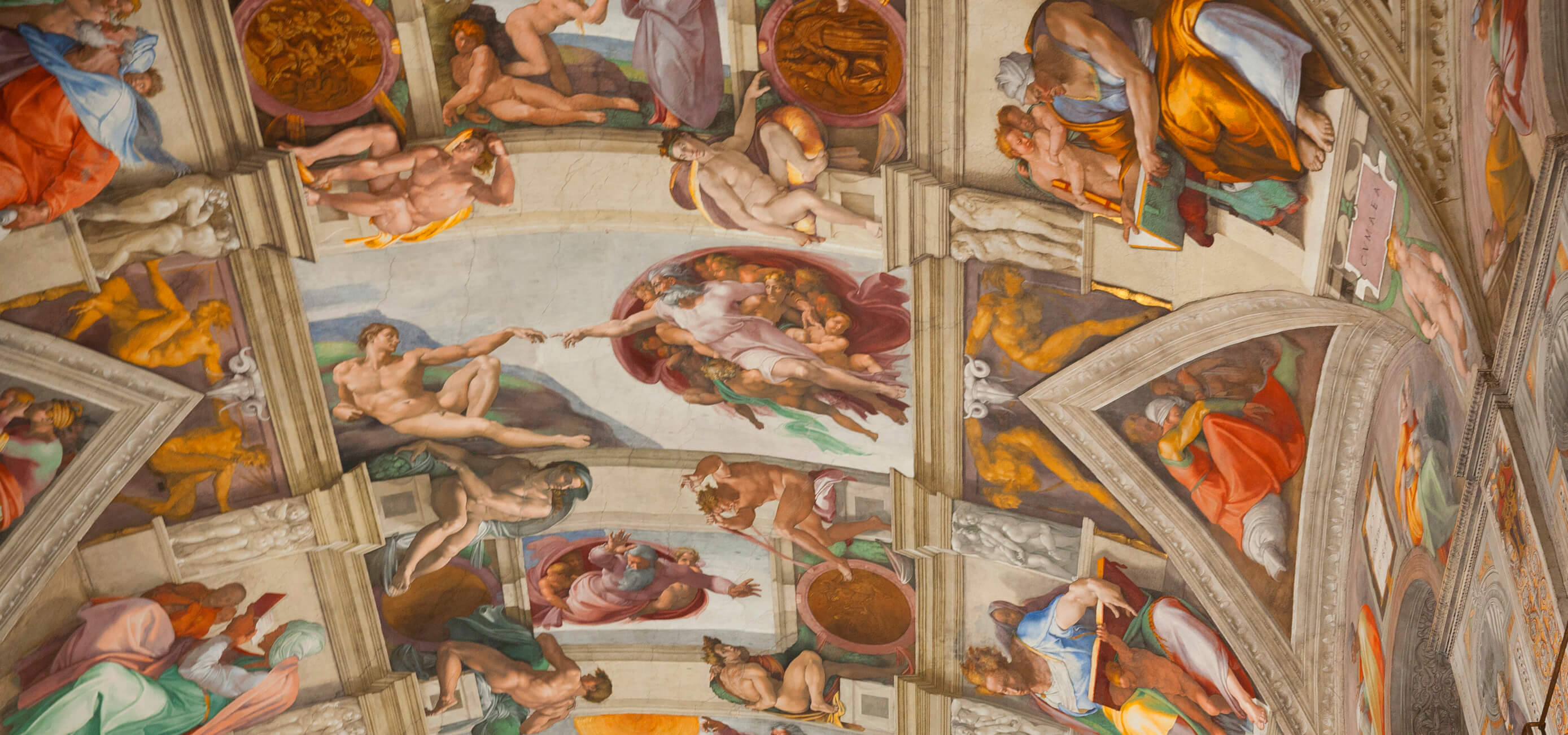
Pristine Sistine - The Chapel at its Best
€89
1794 reviews

Premium Colosseum Tour with Roman Forum Palatine Hill
€56
850 reviews

Pasta-Making Class: Cook, Dine Drink Wine with a Local Chef
€64
121 reviews
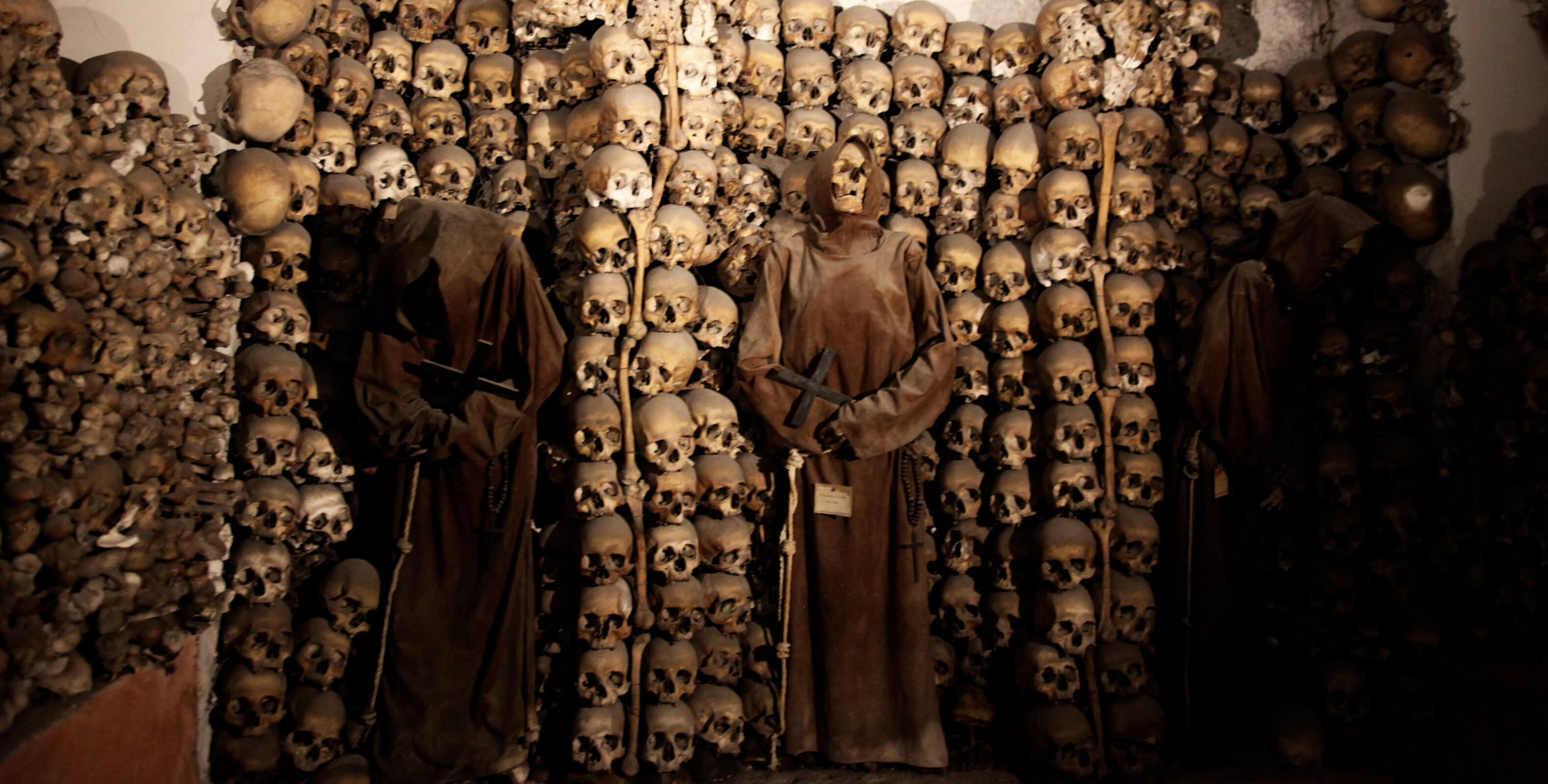
Crypts, Bones Catacombs: Underground Tour of Rome
€69
401 reviews
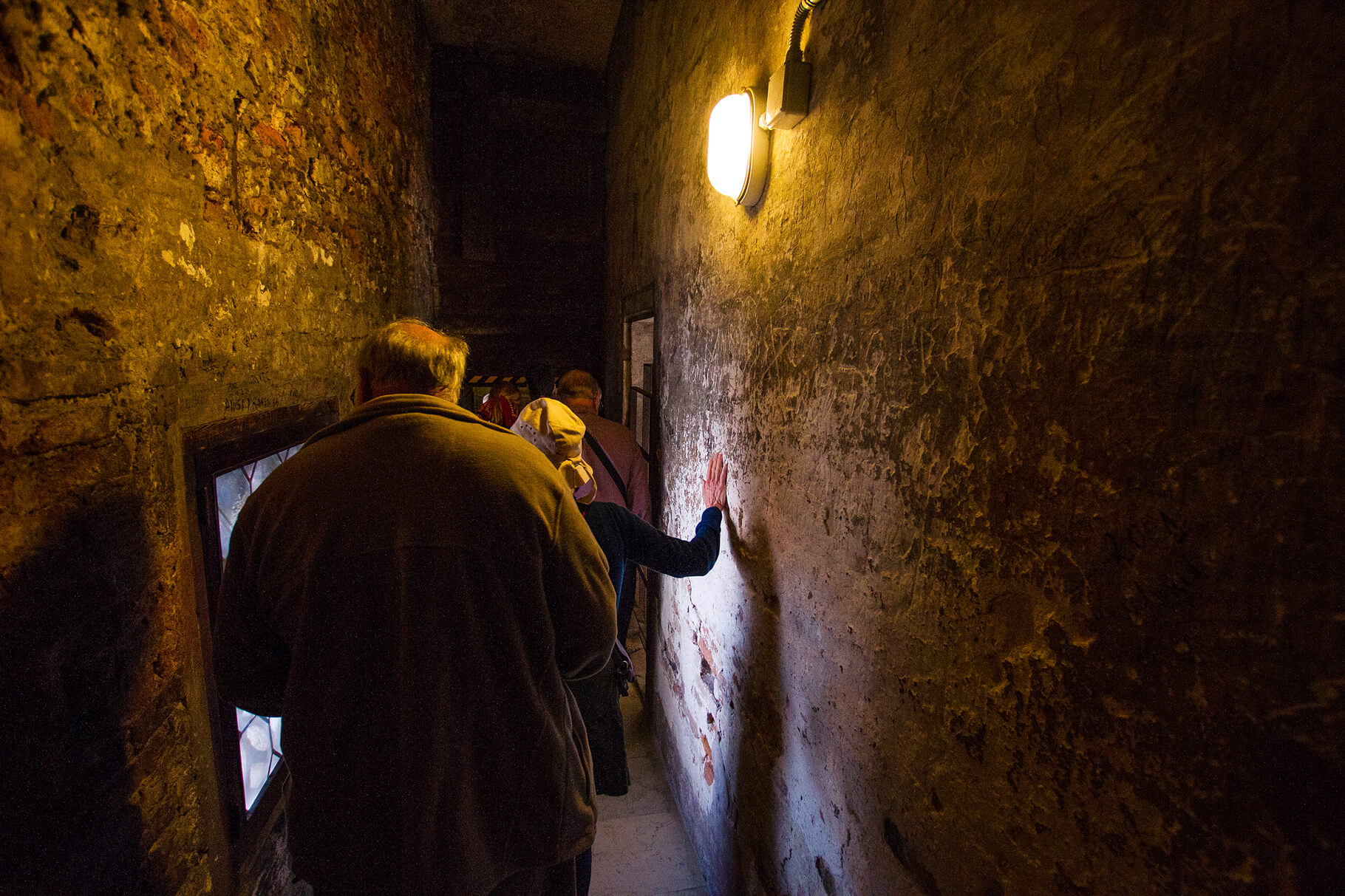
VIP Doge's Palace Secret Passages Tour
€79
18 reviews
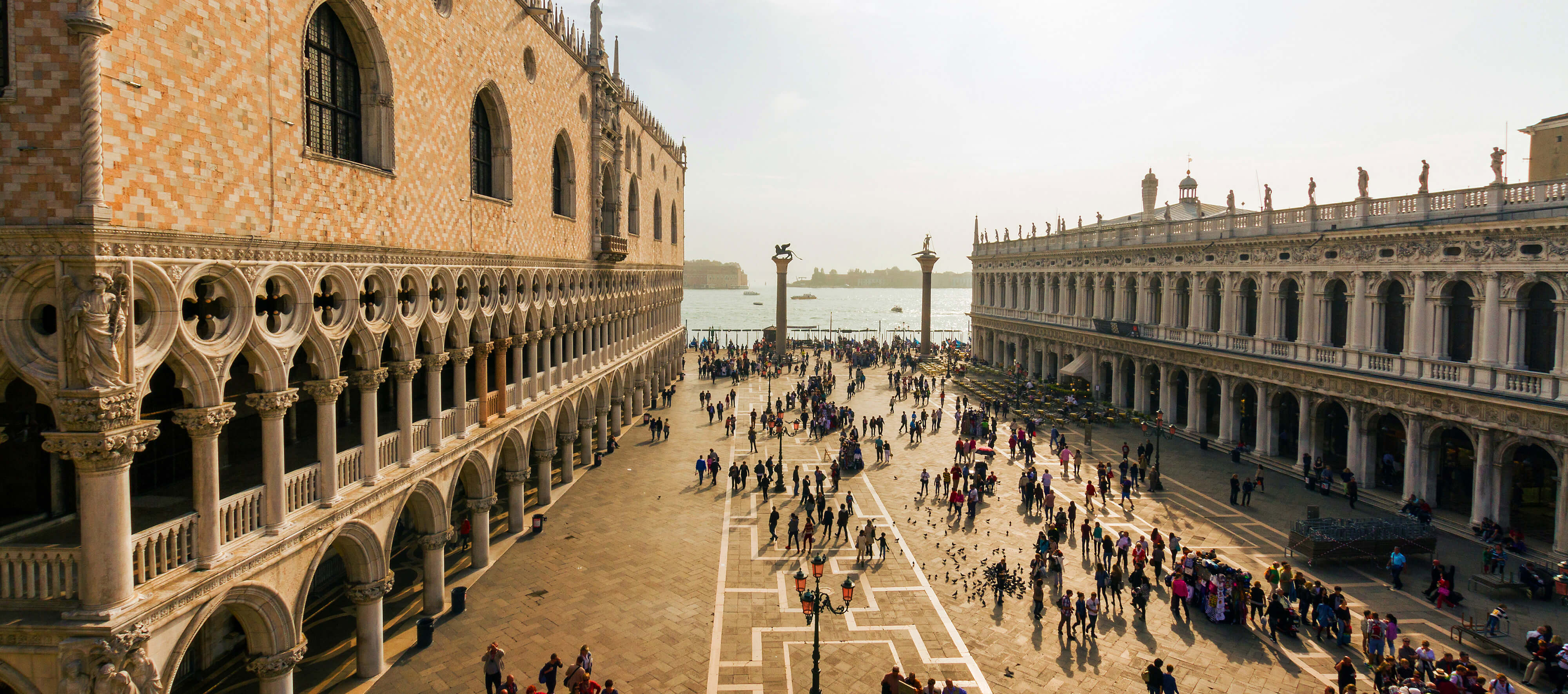
Legendary Venice: St. Mark's Basilica, Terrace Doge's Palace
€69
286 reviews
